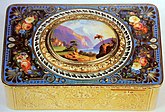
Cameo is a method of carving an object such as an engraved gem, item of jewellery or vessel. It nearly always features a raised (positive) relief image; contrast with intaglio, which has a negative image. Originally, and still in discussing historical work, cameo only referred to works where the relief image was of a contrasting colour to the background; this was achieved by carefully carving a piece of material with a flat plane where two contrasting colours met, removing all the first colour except for the image to leave a contrasting background.

The Walters Art Museum is a public art museum located in the Mount Vernon neighborhood of Baltimore, Maryland. Founded and opened in 1934, it holds collections from the mid-19th century that were amassed substantially by major American art and sculpture collectors, including William Thompson Walters and his son Henry Walters. William Walters began collecting when he moved to Paris as a nominal Confederate loyalist at the outbreak of the American Civil War in 1861, and Henry Walters refined the collection and made arrangements for the construction what ultimately was Walters Art Museum.

Baron Ferdinand de Rothschild, also known as Ferdinand James Anselm Freiherr von Rothschild, was a British banker, art collector and politician who was a member of the Rothschild family of bankers. He identified as a Liberal, later Liberal Unionist, and sat as a Member of Parliament in the House of Commons from 1885 to 1898. Ferdinand had a younger sister, Alice, who like her brother was a keen horticulturalist and collector. She inherited Ferdinand's property, Waddesdon Manor, in 1898 after he died and likewise continued the tradition of using the house as a place to keep his collections.

Schatzkammer, a German word which means "treasury" or "treasure chamber", is a term sometimes used in English for the collection of treasures, especially objets d’art in precious metals and jewels, of a ruler or other collector which are kept in a secure room and often found in the basement of a palace or castle. It also often included the wider types of object typical of the Renaissance cabinet of curiosities. A very small but evocative Renaissance room in a tower at Lacock Abbey was designed for keeping and viewing the treasures of the newly rich owner.
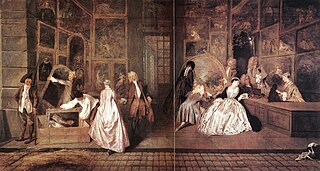
A marchand-mercier is a French term for a type of entrepreneur working outside the guild system of craftsmen but carefully constrained by the regulations of a corporation under rules codified in 1613. The reduplicative term literally means a merchant of merchandise, but in the 18th century took the connotation of a merchant of objets d'art. Earliest references to this Corps de la Ville de Paris can be found at the close of the 16th century, but in the 18th century marchands-merciers were shopkeepers but they also played an important role in the decoration of Paris homes. In fact, they served as general contractors, designing and commissioning pieces of the most fashionable furniture, and often, in addition, worked outside of their shops as interior decorators, responsible for many aspects of a room's decor. In Paris, the guild system, in place since the late Middle Ages, prohibited craftsmen from working with any material with which they had not undergone a formal apprenticeship. Only a marchand-mercier who worked outside of the guild system, therefore, could mount Chinese porcelains with gilt-bronze handles and stands, fit the cabinetmaker's furniture with Japanese lacquer or Sèvres porcelain plaques, and supply furniture with opulent gilt-bronze mounts.

The BnF Museum or Museum of the Bibliothèque nationale de France, formerly known as the Cabinet des Médailles, is a significant art and history museum in Paris. It displays collections of the Département des Monnaies, Médailles et Antiques de la Bibliothèque nationale de France as well as manuscripts and books from the Library's collections. The BnF Museum is located in the Richelieu site, the former main building of the library bordering rue de Richelieu.
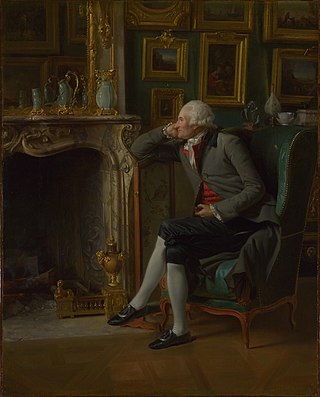
A cabinet painting is a small painting, typically no larger than two feet in either dimension, but often much smaller. The term is especially used for paintings that show full-length figures or landscapes at a small scale, rather than a head or other object painted nearly life-size. Such paintings are done very precisely, with a great degree of "finish".

The Constellation egg is an unfinished 1917 Easter egg designed under the supervision of Peter Carl Fabergé for the last Tsar of Russia, Nicholas II, as an Easter gift to his wife, the Tsarina Alexandra Feodorovna. It was the last Imperial Fabergé egg designed.
Theo Fabergé was a grandson of Peter Carl Fabergé. His father Nicholas Fabergé, Carl's youngest son, arrived in London in 1906 to help run the only branch of the House of Fabergé outside Russia, on Dover Street in London. After 1917, Nicholas remained in London, and in 1922, his son Theo was born. Like his grandfather did, Theo had a fascination with the techniques of ornamental turning, the art of deep-cut engraving and sculpting woods, ivories, gems and metals using precision lathes. This passion would lead to the creation of some of the most ornate and rare Fabergé Eggs since the creation of the Imperial Fabergé Eggs by his grandfather.
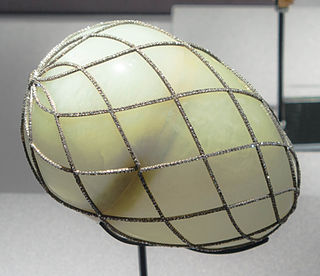
The Diamond Trellis egg is a jewelled enamelled Easter egg made by August Holmström under the supervision of the Russian jeweller Peter Carl Fabergé in 1892. It is one of the Imperial Fabergé eggs, made for Alexander III of Russia, who presented it to his wife, the Empress Maria Feodorovna. The egg is owned by Dorothy McFerrin, as part of the collection acquired by her and her husband, Artie McFerrin, who died on 8 August 2017, and is on display at the Houston Museum of Natural Science.

Cameo glass is a luxury form of glass art produced by cameo glass engraving or etching and carving through fused layers of differently colored glass to produce designs, usually with white opaque glass figures and motifs on a dark-colored background. The technique is first seen in ancient Roman art of about 30 BC, where it was an alternative to the more luxurious engraved gem vessels in cameo style that used naturally layered semi-precious gemstones such as onyx and agate. Glass allowed consistent and predictable colored layers, even for round objects.

Hardstone carving, in art history and archaeology, is the artistic carving of semi-precious stones, such as jade, rock crystal, agate, onyx, jasper, serpentinite, or carnelian, and for objects made in this way. Normally the objects are small, and the category overlaps with both jewellery and sculpture. Hardstone carving is sometimes referred to by the Italian term pietre dure; however, pietra dura is the common term used for stone inlay work, which causes some confusion.

Limoges enamel has been produced at Limoges, in south-western France, over several centuries up to the present. There are two periods when it was of European importance. From the 12th century to 1370 there was a large industry producing metal objects decorated in enamel using the champlevé technique, of which most of the survivals, and probably most of the original production, are religious objects such as reliquaries.
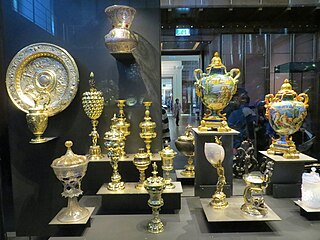
In 1898, Baron Ferdinand de Rothschild bequeathed to the British Museum as the Waddesdon Bequest the contents from his New Smoking Room at Waddesdon Manor. This consisted of a wide-ranging collection of almost 300 objets d'art et de vertu, which included exquisite examples of jewellery, plate, enamel, carvings, glass and maiolica. One of the earlier objects is the outstanding Holy Thorn Reliquary, probably created in the 1390s in Paris for John, Duke of Berry. The collection is in the tradition of a schatzkammer, or treasure house, such as those formed by the Renaissance princes of Europe; indeed, the majority of the objects are from late Renaissance Europe, although there are several important medieval pieces, and outliers from classical antiquity and medieval Syria.

The Five Senses is a set of allegorical paintings created at Antwerp in 1617-1618 by Jan Brueghel the Elder and Peter Paul Rubens, with Brueghel being responsible for the settings and Rubens for the figures. They are now in the Prado Museum in Madrid. They are all painted in oils on wood panel, approximately 65 by 110 centimetres in dimensions.
Lignereux is a French company, founded in 1787, which produces objets d'art. Established in Paris and London, Lignereux plays a major role in decorative arts. Lignereux makes objects which are intended for art collectors. In 2015 Lignereux began to produce new objects, decorated by contemporary artists and craftspeople.

The Diptych of an elderly couple is a pair of bust-length wedding portraits by Hans Memling, which were formerly attached with pegs and were split some time before they were sold separately in 1894. One is in the collection of the Gemäldegalerie and the other is in the collection of the Louvre. When viewed side by side the landscape background joins up to form a whole.

Charles Henry Truman, FSA, was an art historian and a leading authority on gold boxes.
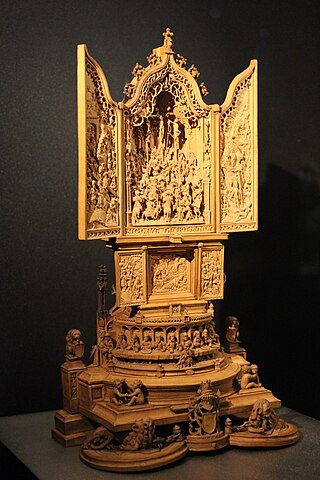
The miniature altarpiece in the British Museum, London, is a very small portable Gothic boxwood miniature sculpture completed in 1511 by the Northern Netherlands master sometimes identified as Adam Dircksz, and members of his workshop. At 25.1 cm (9.9 in) high, it is built from a series of architectural layers or registers, which culminate at an upper triptych, whose centre panel contains a minutely detailed and intricate Crucifixion scene filled with multitudes of figures in relief. Its outer wings show Christ Carrying the Cross on the left, and the Resurrection on the right.

The Art Collection of James-Alexandre, comte de Pourtalès-Gorgier was a collection of sculpture, antiques and paintings owned by James-Alexandre de Pourtalès, Comte de Pourtalès-Gorgier until his death in 1855.





